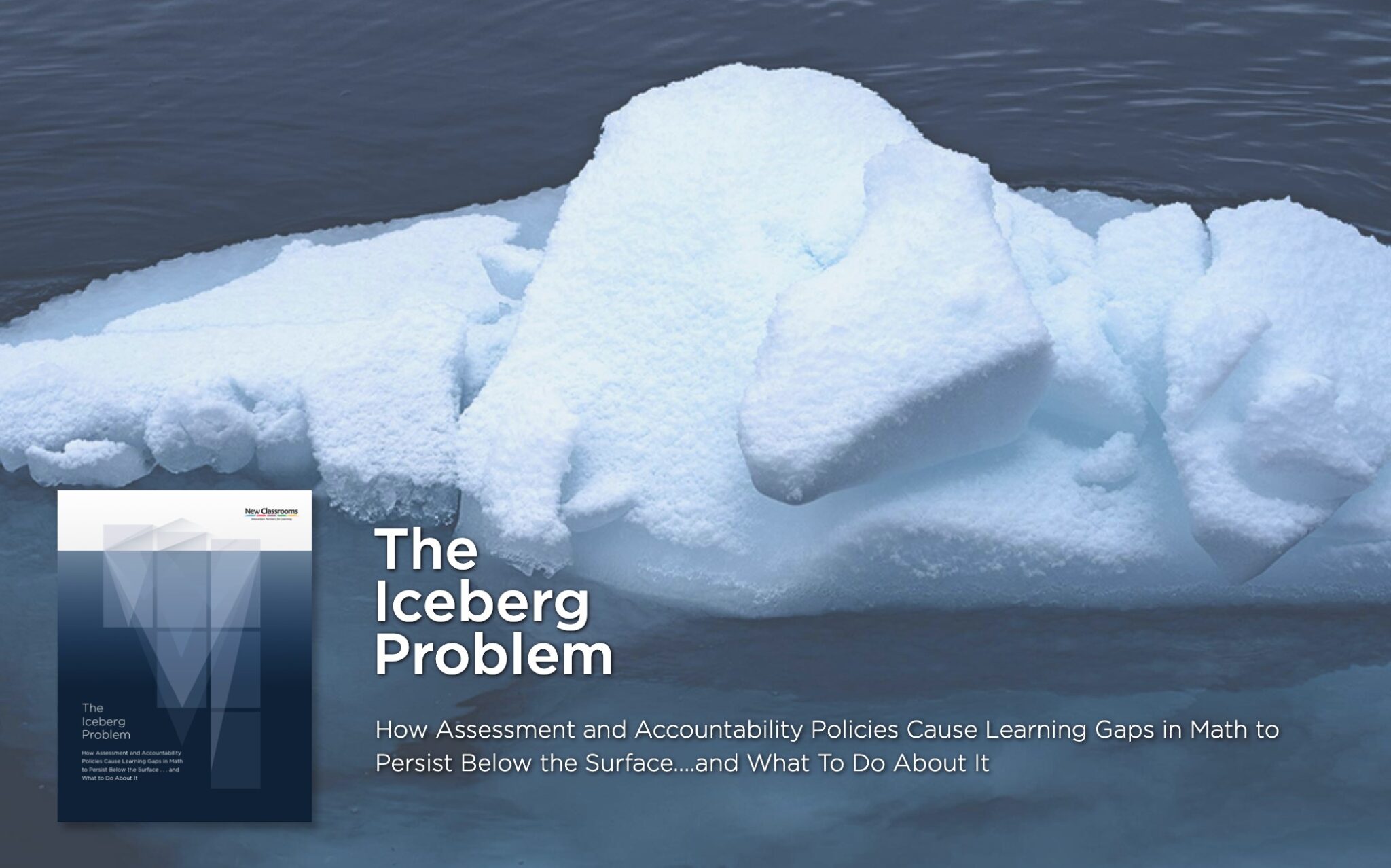Iceberg Problem: How Current Education Policies Can Inadvertently Cause Learning Gaps in Math to Accumulate
September 24, 2019
Recommends updating assessment and accountability policies so teachers can better meet students’ unique strengths and needs
New York, NY – A new report, released today by New Classrooms Innovation Partners, highlights how today’s accountability policies tied to annual, grade-level assessments can inadvertently hinder students’ educational progress in math. Because math is cumulative and many students arrive into middle and high school with unfinished learning from prior years, federal and state policies that incentivize an exclusive instructional focus on grade-level material can actually cause learning gaps to accumulate. This can make it harder for students to master the more advanced mathematical concepts required for college and career readiness. The report is called The Iceberg Problem because, like an iceberg, only a very small amount of information is visible (grade-level performance) while the more comprehensive information remains hidden from view.
The report, “The Iceberg Problem: How Assessment and Accountability Policies Cause Learning Gaps in Math to Persist Below the Surface…and What To Do About It,” was funded by the Barr Foundation, Carnegie Corporation of New York and the Nellie Mae Education Foundation. With input from dozens of educators and policy makers, this paper calls for education leaders to advance a future vision of assessment and accountability policies that adhere to the principles of transparency, equity and rigor while also enabling instructional approaches tailored to each student’s unique strengths and needs.
According to the 2017 National Assessment of Educational Progress (NAEP), only 40 percent of fourth-grade students are grade-level proficient in math. For students from historically disadvantaged populations, including students of color and those from low-income backgrounds, proficiency rates are even lower. This means many are starting middle school without key foundational concepts that are necessary to succeed in middle-grade math. And yet, federal and state educational policies signal to teachers that they should teach grade-level material to all students, regardless of their unique starting points. This may be one reason why, in math, proficiency rates on NAEP typically decline between the fourth and eighth grades while reading scores hold steady or improve.
“Expecting educators to teach to the wide range of their students’ skill levels while also comprehensively covering all grade-level material is not a recipe for student success,” said Joel Rose, CEO of New Classrooms. “High expectations and accountability for results are essential, but it is just as important to honestly acknowledge where students are starting from so they can access a viable path to get them to where they need to be. Federal and state educational policies must shift to create the space for more tailored approaches to instruction and assessments that are grounded in college and career readiness but flexible in the pathways that students can take to get there.”
In addition to providing instructional supports for teachers to address unfinished learning, districts and states should evolve their assessment systems to measure learning growth using adaptive assessments that span multiple grade levels in order to measure learning gains from each student’s unique starting point. Further modifying statewide accountability systems to emphasize proficiency outcomes at targeted grade levels, rather than every year, will allow schools to shape multi-year instructional programs aligned to students’ long-term success.
As part of the report, New Classrooms reviewed publicly available research, conducted focus groups with teachers and used its own programmatic data generated from Teach to One: Math, a middle and high school math program that uses a combination of live, online and collaborative learning in ways that enable each student to receive personalized instruction each day. In schools using Teach to One: Math in ways that allowed for a student to access content at their assessed skill level, rather than narrower range of skills more strictly aligned with their assigned grade, students grew an average of 38 percentile points on NWEA’s Measures of Academic Progress. Those schools that configured the program to emphasize grade-level proficiency grew seven points.
“This is a brave report that is long overdue,” said Philip Uri Treissman, Professor of Mathematics at The University of Texas at Austin. “The Iceberg Problem illuminates the need for all education stakeholders – leaders, advocates, teachers, policymakers and philanthropists – to come together and candidly confront the hidden barriers in our education system. It is through these conversations that we can lay the foundation for policies that can ensure all students – particularly those traditionally underserved – have access to an excellent math education.”
About New Classrooms
Founded in 2011, New Classrooms Innovation Partners is a national nonprofit on a mission to personalize education by redesigning how a classroom works – from the use of technology, time, and physical space to the instruction and content that engages each student. The founders of New Classrooms were the leaders of an initiative within NYC Public Schools called School of One, which TIME named as one of the Best Inventions of the Year. New Classrooms’ first learning model, Teach to One: Math, ensures each student is learning the right math lesson, at the right time, and in the right way that best meets their strengths and needs. It is used by thousands of students in schools nationwide.